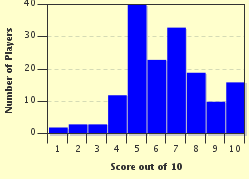Quiz Answer Key and Fun Facts
1. The lima bean got its name because crates shipping them back to Spain from the New World were labelled with the city of origin, Lima, Peru. By what name are lima beans, especially the smaller sieva variety, called in some places?
2. This photo shows a pot of chili sin carne. What ingredient usually found in standard Mexican chili (or more fully, chili con carne) is missing from this dish?
3. This is a picture of a Spanish Ensalada de Garbanzo. What is the more common English-language name for these relatively large whitish beans which the Spanish call garbanzos?
4. This photo shows cassoulet, a slow-cooked stew made with white beans and (depending on the exact recipe) one or more types of meat. In which of these cities would you be most likely to find cassoulet on the menu in a restaurant?
5. In the Middle East, you will find hummus, a delicious spread made from chickpeas, served with almost any meal. Aside from chickpeas, it traditionally contains all of the following flavorings EXCEPT which of these?
6. Around the eastern end of the Mediterranean, another popular food is the falafel, a fried ball made from ground chick peas (or, depending on the region, fava beans). When you buy falafel from a street vendor, how is it likely to be presented?
7. This picture shows an Indian flatbread made from black gram (urad in Hindi) flour. What is its name?
8. Wherever you go on the Indian subcontinent, you are likely to find this delicious dish, made by stewing any of a number of types of pulses with selected spices, being served. What is it called?
9. Where in the world would you be most likely to find yourself served with a meat pie floating in a serve of pea soup, possibly while watching a game of AFL at Football Park?
10. This jelly mooncake is filled with an ingredient, essential to many eastern Asian sweet dishes, which is made by mixing boiled azuki beans with honey or sugar. What is it called?
Source: Author
looney_tunes
This quiz was reviewed by FunTrivia editor
WesleyCrusher before going online.
Any errors found in FunTrivia content are routinely corrected through our feedback system.


